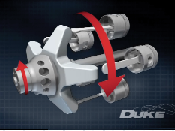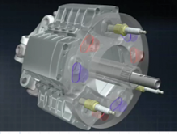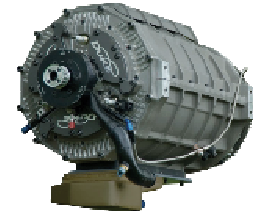The Low Vibration Duke Engine
The Noise, Vibration and Harshness of an engine are not only important from an engineering perspective but impact on the entire system of which the engine is just a part. The Duke Engine offers outstanding positive NVH benefits.

Mechanical forces from rotating and reciprocating systems in the axial arrangement of the Duke engine are very different from any conventional engine. The sinusoidal reciprocating force from each cylinder combined with the inertial forces from the nutating body sum up to leave a simple first order balance couple, which can be fully resolved using basic fixed masses on the Z crankshaft. The Nutating reciprocator leads to very low angles of con rod articulation (<3Deg deviation from cylinder axis) resulting in near sinusoidal reciprocating motion, meaning there are negligible secondary or higher order vibration forces generated within the reciprocating system. This is in stark contrast to conventional engines where unresolved second order vibrations can dominate the mechanical vibration levels, as in the case of a conventional in-line 4-cylinder engine. Many conventional 4-cylinder engines are fitted with twin balancer shaft systems driven at twice engine speed to enable such engines to meet market acceptance levels.
It is reasonable to say that the mechanical balance of the Duke Engine is near perfect, without the added complexity of additional balance shafts etc.

If a variable compression ratio Duke engine is considered, the near perfect balance could be maintained throughout any compression ratio variation. Many mechanisms proposed to achieve variable compression ratio in conventional engines introduce or change vibrations between low and high ratio positions. The counter-rotating cylinder group and crankshaft in the Duke engine provide the dynamic equivalent of twin-contra-rotating flywheels. Torque cancellation occurs between the contra rotating flywheels during speed fluctuations. As a result the Duke engine sees a reduction in the instantaneous torque oscillation at engine mounts, compared to a single flywheel conventional engine.
Mechanical Vibration is a standout benefit area for the Duke Engine.

